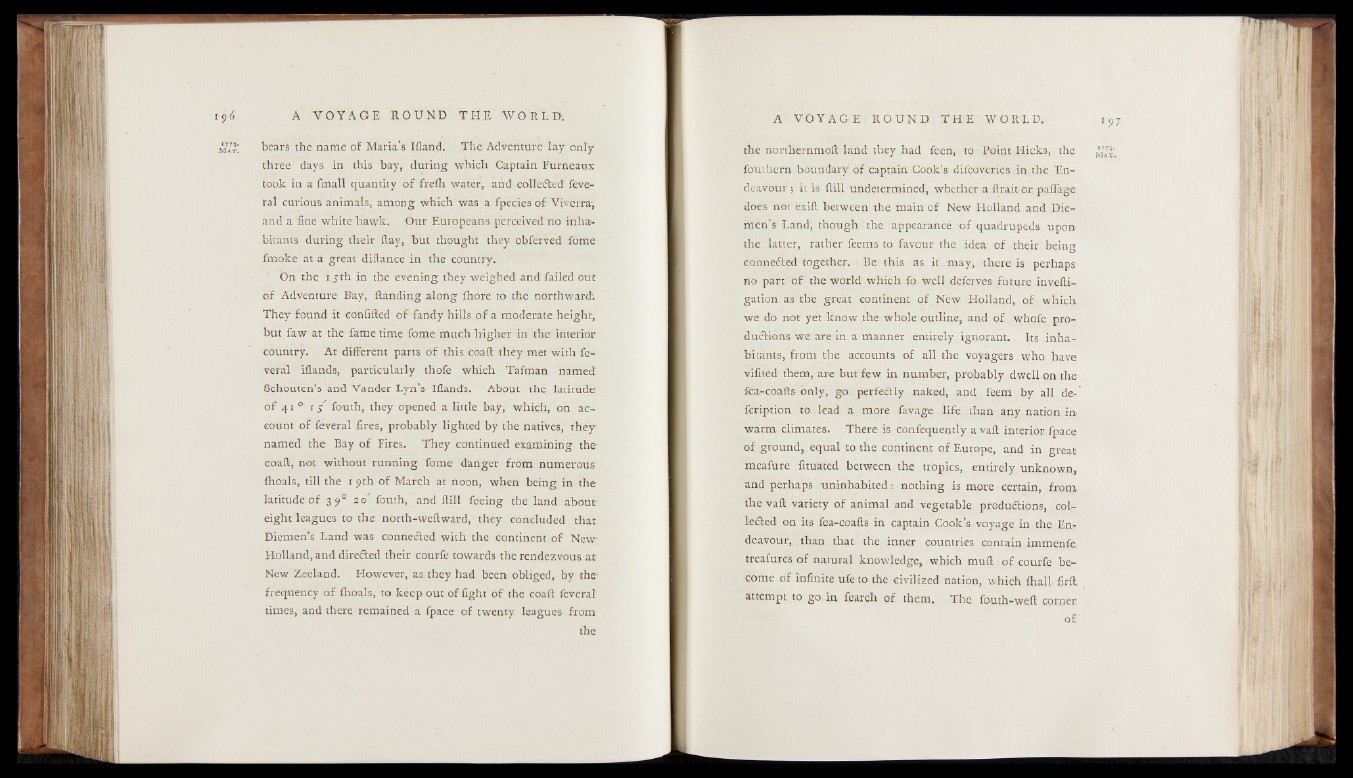
m7” ; bears the name of Maria’s Ifland. The Adventure lay only
three days in this bay, during which Captain Furneaux
took in a fmall quantity of frefh water, and collected feve-
ral curious animals, among which was a fpecies of Viverra,
and a fine white hawk. Our Europeans perceived no inhabitants
during their flay, but thought they obferved fome
fmoke at a great diftance in the country.
On the i yth in the evening they weighed and failed out
of Adventure Bay, Handing along fhore to the northward.
They found it eonfifted o f fandy hills of a moderate height,
but faw at the fame time fome much higher in the interior
country. At different parts of this coaft they met with fe-
veral iflands, particularly thofe which Tafman named
Schouten’s and Vander Lyn’s Iflands. About the latitude
of 41 ° i s fouth, they opened a little bay, which, on account
of feveral fires, probably lighted by the natives, they
named the Bay of Fires. They continued examining the
coaft, not without running fome danger from numerous-
fhoals, till the 1 pth of March at noon, when being in the
latitude of 39° 20' fouth, and ftill feeing the land about
eight leagues to the north-weftward, they concluded that
Diemen’s Land was connected with the continent of New
Holland, and directed their courfe towards the rendezvous at
New Zeeland. However, as they had been obliged, by the-
frequency of fhoals, to keep out of fight of the coaft feveral'
times, and there remained a fpace of twenty leagues from
the
the northernmoft land they had feen, to Point Hicks, the mH..
fouthern boundary of captain Cook’s difcoveries in the Endeavour
; it is ftill undetermined, whether a ftrait or paffage
does not exift between the main of New Holland and Diemen’s
Land; though the appearance of quadrupeds upon
the latter, rather feems to favour the idea of their being
connected together. Be this as it may, there is perhaps
no part of the world which fo well deferves future invefti-
gation as the great continent of New Holland, of which
we do not yet know the whole outline, and of whofe productions
we are in a manner entirely ignorant. Its inhabitants,
from the accounts of all the voyagers who have
vifited them, are but few in number, probably dwell on the
fea-coafts only, go perfectly naked, and feem by all de-
fcription to lead a more favage life than any nation in
warm climates. There is confequently a vaft interior fpace
of ground, equal to the continent of Europe, and in great
meafure fituated between the tropics, entirely unknown,
and perhaps uninhabited: nothing is more certain, from
the vaft variety of animal and vegetable productions, collected
on its fea-coafts in captain Cook’s voyage in the Endeavour,
than that the inner countries contain immenfe.
treafures of natural knowledge, which mull of courfe become
of infinite ufe to the civilized nation, which Ihall firff
attempt to go. in fearch of them. The- fouth-weft corner.
of